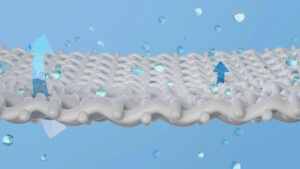
Don’t Fall for the Moisture Wicking Myth
Moisture wicking is one of the most overused claims in activewear — but very few fabrics actually deliver. Most gear traps sweat and odor, while

Moisture wicking is one of the most overused claims in activewear — but very few fabrics actually deliver. Most gear traps sweat and odor, while

Activewear fabric matters more than you think. Most people judge activewear by how it looks or feels — but rarely stop to ask: what is

Fast fashion is everywhere — and it’s especially rampant in activewear. That trendy pair of leggings? Likely made of cheap synthetic materials like polyester, built

A capsule activewear wardrobe is the secret to less clutter, better workouts, and toxin-free comfort that lasts. Most people have a drawer full of activewear

Most people don’t realize how much contact their activewear has with their body — or how much that contact can actually matter. Your skin is

When we set out to create EveryRep, we knew finding the right sustainable activewear fabric would make or break everything. We weren’t satisfied with “good

Why We Started EveryRep We didn’t set out to make just another activewear brand. We started EveryRep because we were tired of what the industry
Join EveryRep for early access to exclusive fabrics and unlock your welcome perk. Get 10% off your first purchase today!
By signing up you agree to receive EveryRep emails. Unsubscribe anytime. See our Terms of Use and Privacy Policy for further information.
This is a semi-synthetic fibre derived from wood pulp. While it’s made from naturally occurring cellulose, the process of transforming this cellulose into usable rayon fibres involves chemical alterations, making it a man-made fiber. The transformation of plant cellulose into rayon raises several environmental concerns. The chemicals used in this process, such as carbon disulfide, are hazardous and can have detrimental impacts on the environment and human health.
Cotton production uses 6% of the world’s pesticides and 16% of all insecticides, more than any other crop. These are harmful to the soil, release greenhouse gases, and pollute drinking water. Cotton production wastes HUGE amounts of water, requiring over 700 gallons to make a single cotton t-shirt.
Another popular fabric used in the fashion industry, nylon is a synthetic, man-made fibre sourced from petrochemicals and crude oil extracts. It is non-breathable and absorbs little to no moisture. Nylon is not biodegradable, it persists in the environment indefinitely and releases harmful microplastics into our waterways and food supply.
By entering your email address you agree to receive updates from EveryRep, please see our Privacy Policy
This fibre is made of plastic, through an energy-wasting chemical process of petroleum or coal. Polyamide fabric production has huge negative impacts on the environment and human health. Polyamide fabric releases plastic microfibers into the environment that pollute entire food chains, kill land and marine wildlife, and endanger human health. These plastic microfibers are consumed by fish and birds and end up in our food, lungs, and stomachs. Polyamide fabric takes hundreds of years to decompose. As polyamide breaks down, it releases toxic chemicals and greenhouse gases into the environment.
The most popular fabric in the athletic industry due to its low cost, this petroleum-based fibre is made of plastic. Its production utilizes formaldehyde, PFOA, and PFCs, chemicals which pollute the environment and are highly toxic to wildlife and people. The clothing produced from this fibre sheds harmful microplastics when washed and worn. It is non-breathable, is a breeding ground for unpleasant odors, and its use in undergarments has been linked with infertility.

WASHING
Machine wash inside out using cold water preferably on gentle cycle. Avoid harsh detergents and bleaches, as they can damage the fabric’s integrity.
SOFTENERS
It is best to avoid fabric softeners, their use is not required as our clothing is already extremely soft. Fabric softeners function by creating a thin chemical film on your garments, which can hinder their positive attributes, such as breathability and moisture absorbency.
DRYING
Tumble dry on a low heat setting or hang-dry for the best long term performance. Remove from the dryer promptly.
IRONING
Use a low heat setting. The steam setting will remove wrinkling the most effectively.

FIll out the form below and we will get back to you as soon as possible
| Fabric Type | Moisture Absorption | Moisture Evaporation | Odor Blocking |
|---|---|---|---|
| Cotton | High | Slow | No |
| Polyester | Low | Fast | No |
| Wool | High | Slow | Yes |
| EveryRep | High ✔ | Fast ✔ | Yes ✔ |